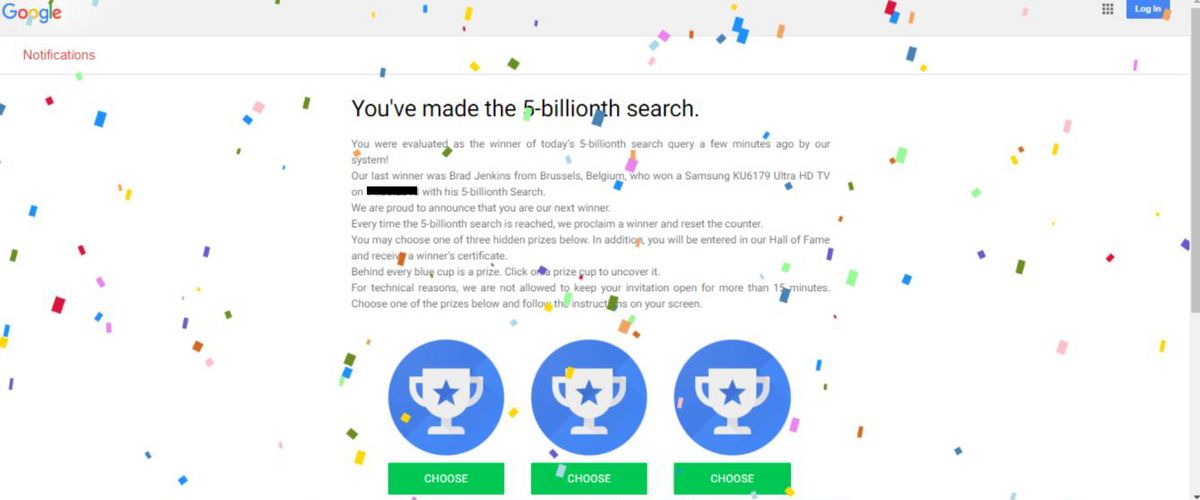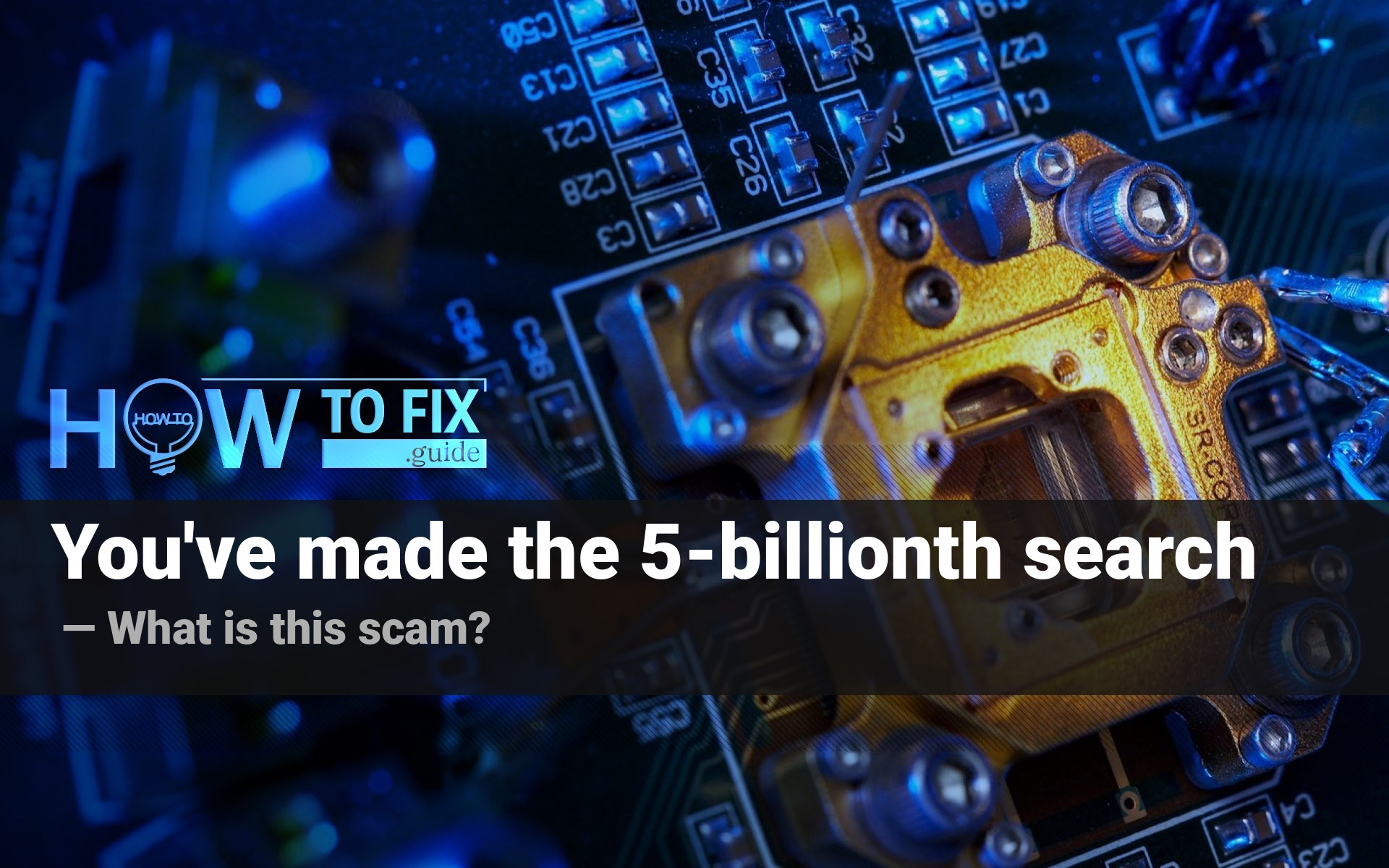You can spectate the “You’ve made the 5-billionth search” notifications in your web browser. Although those pages contain information that looks trustworthy, this page is a sure sign of malware presence.
What is the “You’ve made the 5-billionth search” page?
This website appears unpredictably – at the moment when you are opening your web browser or when clicking on the link/banner on a certain website. Regardless of how you have triggered this page’s appearance, you will see there the offer to receive a prize. The reason for such kindness is explained as “you have done the 5-billionth search”. The site says that the previous winner received a Samsung TV, but you can get a different prize – click on one of the cups below.

After clicking on the cup, you will see the window that says you have won a certain prize. Each victim will see the random item – the website generates it at the moment of your click. Then, you are offered to fill a simple form to receive the prize. All you have to type in your email address, phone number, shipping address, and name. As you can guess, you will not receive anything. This scam aims at your personal information – and you are giving it to these crooks with your hands.
How dangerous is the “You’ve made the 5-billionth search” scam?
Data collecting became a usual part of the modern Internet. Google, Facebook, Twitter, any other large service collects information about their users for various purposes. However, these services use your data by showing you more relevant ads and offers of potential friends on social networks. This target is pretty benevolent, so there is no reason to be afraid of it.

The example of advertisements based on your data collected by various services
Nevertheless, I can’t say the same thing about the situation when the “You’ve made the 5-billionth search” site takes your information. As it was mentioned, spectating this page is likely a sign of malware presence – primarily, adware or browser hijacker. Hence, it is easy to conclude that this page is malevolent, too. And while legit services manage your information to make your daily activities more comfortable, those crooks will bring a lot of problems in your life.
History repeats itself
This scam is not the first case of such data stealing. You could spectate the same scams on the Internet through the past half of 2021. Such things as the $1000 Amazon Gift card scam or Verizon rewards scam are examples of the same activity, but with other disguises. In those scams, databases with information about people who were bait on this scam were then sold to third parties. And no one can say for sure how this data will be used. You may start receiving tons of email spam, as well as constant SMS on your phone offering some other unwanted things. Email messages may contain the phishing link – just like Debt Settlement email scam or Kaspersky email scam.
Pay attention to this: Pornographic Virus Alert from Microsoft
How dangerous is the adware?
Adware that has likely caused the appearance of the “You’ve made the 5-billionth search” website cannot deal a lot of harm directly. This malware changes your system configurations, but these alterations are too weak to damage your system. It usually modifies the HOSTS file, Task Scheduler, and several registry keys. Those actions make the virus constantly active and show you the ads even if you are not using the web browser.
When the adware is active, you can see that websites are flooded with different banners. Your web browser will start opening autonomously – thanks to the task created by adware in the Task Scheduler. Moreover, the adware can make your system slower – especially if you have an outdated PC or a cheap laptop. Since the majority of web browsers consume a lot of RAM, weak computers will freeze at the moment when adware opens your browser. And it may happen whenever – even when you are working on some important project.
How to get rid of adware and forget about the “You’ve made the 5-billionth search” page?
The best way to eliminate any malware is to use anti-malware software. Of course, it is possible to clean the system manually, but each adware makes unique changes to your system. All of these changes must be reverted to the original – otherwise, you may suffer from various problems in the future. But which antivirus is the best for that purpose?
You may see the offers to use Microsoft Defender – an embedded anti-malware program that is present in Windows exactly after the installation. Besides the fact that Defender has an excellent detection database, it cannot recover the web browsers after the adware activity. To do all actions in just several clicks, I can recommend you to use GridinSoft Anti-Malware.
Removing the viruses with GridinSoft Anti-Malware
- Download and install GridinSoft Anti-Malware. After the installation, you will be offered to perform the Standard Scan. Approve this action.
- Standard scan checks the logical disk where the system files are stored, together with the files of programs you have already installed. The scan lasts up to 6 minutes.
- When the scan is over, you may choose the action for each detected virus. For all files of adware the default option is “Delete”. Press “Apply” to finish the malware removal.



When the computer is cleaned, you can go further – to the browser reset. This action is needed to wipe out the changes done by adware
Reset your browser settings with GridinSoft Anti-Malware
To reset your browser with GridinSoft Anti-Malware, open the Tools tab, and click the “Reset browser settings” button.

You can see the list of the options for each browser. By default, they are set up in a manner that fits the majority of users. Press the “Reset” button (lower right corner). In a minute, your browser will be as good as new.

The browser reset is recommended to perform through the antivirus tool by GridinSoft because last can also reset the HOSTS file without any additional commands.
User Review
( votes)





It’s frustrating to see these scams proliferate, especially with so many people actively searching for information. Increased awareness and sharing tips on identifying these scams would be really helpful. I’m curious if there are specific tools or resources we can use to report or block these scam websites effectively!
It’s alarming to see how prevalent scams have become, especially with so many people spending time online. I appreciate the insights you’ve shared on this issue. One suggestion I’d like to add is to always double-check the URL and avoid clicking on suspicious links. Awareness is key to staying safe!
Great post! It’s alarming how scams are becoming more sophisticated. Thanks for sharing tips on how to spot them. I’ll definitely be more cautious with my searches!